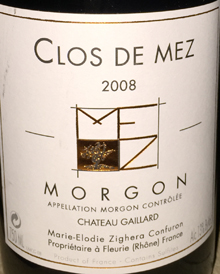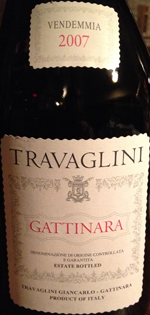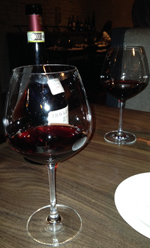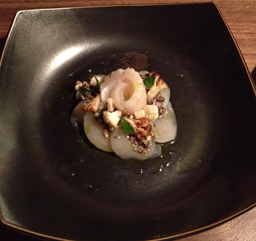

Note: This review is under founding chef Michael Toscano, who left the restaurant in November 2014 for an opportunity in Charleston, South Carolina. Later still, Perla moved to a new space at 234 W. 4th Street, where it is now called Perla Cafe. Despite the similar name, it is now more casual, and is both less expensive and less fancy than it was when I wrote this review.
*
 I’ll admit it: I went to Perla with a poison pen in hand, ready to hate the place on the slightest provocation. I was annoyed by the presumption of its hideously over-priced wine list and its self-serving no-reservations policy.
I’ll admit it: I went to Perla with a poison pen in hand, ready to hate the place on the slightest provocation. I was annoyed by the presumption of its hideously over-priced wine list and its self-serving no-reservations policy.
 Why go at all? The reviews were rapturous, and the chef, Michael Toscano, had impressed me at Manzo, where he cooked a meat-centric menu for Mario Batali and the Bastianiches at Eataly.
Why go at all? The reviews were rapturous, and the chef, Michael Toscano, had impressed me at Manzo, where he cooked a meat-centric menu for Mario Batali and the Bastianiches at Eataly.
Two dinners later, I’m a fan. More than any restaurant since Locanda Verde, Perla has rustic Italian cuisine nailed. And unlike Locanda, the chef—at least for now—is in the kitchen, and not distracted by running other restaurants. And what else is there, quite like Perla? Peasant perhaps?
As I’ve noted in the past, Italian restaurants are the most over-saturated genre in New York. Perla isn’t the best one, but in the niche it occupies—casual, rustic, and hearty—it is just about perfect.
The managing partner, Gabe Stulman, has become reigning savant of “The Way We Eat Now.” Just 31 years old, he has opened six restaurants in six years, and has yet to fail.
Stulman hated that his first two places, The Little Owl and Market Table, took reservations:
Little Owl really became its own beast. As it got more attention from reviews and stuff, it turned into the kind of place where you had to make dinner reservations a month in advance, which started bringing in a different crowd. Who plans where they’re going to eat dinner a month in advance? Tourists and people who have assistants to book things for them. It wasn’t a neighborhood place anymore with real regulars. It’s hard to tell friends who stop by that they’re going to have to wait two hours and you can’t even offer them a barstool to wait on. I realized I wanted a change.
(He had a nasty split from his Little Owl partners; one gets the sense that there’s more to this story.) Not taking reservations has become practically a religion to him:
I like no reservations way more. There’s less expectation and there’s less sense of entitlement from the guest. I think that when people make a reservation a month in advance, there is more of a sense of an expectation of the meal or, ‘this shit better be awesome and you better live up to that.’ That’s an awesome challenge and I embrace that, but with no reservations it’s way more casual and, I think, more fun.
He told The Times, “The less accessible you make your place to a wider audience…the more accessible you make it to a local audience.” This is a dodge, and surely Stulman knows it. The restaurants are packed because they’re destinations. No single restaurateur could open six restaurants in six years in a few blocks’ radius, and survive on local diners alone.
High-minded justifications for not taking reservations often wither when reality sets in. Having never failed, Stulman hasn’t confronted this possibility. But it would be nice if he’d just admit that the policy is more for his convenience than the customer’s. In an otherwise glowing review, Pete Wells called him on the hypocrisy of it. From the man who complained that his friends had to wait two hours to get into The Little Owl, what do we have?
Currently only six tables can be reserved; the rest are first come first served, a policy that is easier to take at an ambitious bar than at a restaurant where you are encouraged to order antipasti, primi and secondi, and where a roast chicken for two costs $65.
Dining at Perla takes a significant commitment of time and money. The restaurant should make a reciprocal commitment, rather than force customers to stand around near the bar — not at the bar (stools are reserved for dining at peak hours), but near the bar. By 8 p.m. the mob gets thick and the wait can be two hours.
 You wonder how much he’s losing? From 4:30pm till about 7:00, there are empty seats at Perla. Those who’ve heard about the punishing waits may be staying away, not realizing that the place is wide open and available.
You wonder how much he’s losing? From 4:30pm till about 7:00, there are empty seats at Perla. Those who’ve heard about the punishing waits may be staying away, not realizing that the place is wide open and available.
It must be noted: Perla’s informal rusticity is only skin deep: dinner will easily run you $100 a head, and it could go much higher than that, depending on how much you drink.
 Leaving aside Stulman’s nauseating sanctimoniousness, he hires good people. Many of the staff are fellow University of Wisconsin grads (he even calls his four-restaurant empire “Little Wisco”). They’re all friendly, gregarious, and eager to please.
Leaving aside Stulman’s nauseating sanctimoniousness, he hires good people. Many of the staff are fellow University of Wisconsin grads (he even calls his four-restaurant empire “Little Wisco”). They’re all friendly, gregarious, and eager to please.
The menu is in the standard four parts (antipasti, primi, secondi, contorni). It changes frequently, and prices are edging up: just two weeks ago, the most expensive pasta was $21. Today, it is already $25. The entrée average is around $30; soon, it will no doubt rise.


But the food is great. On my first visit, I started with the Tramezzini ($8; above left), a snack resembling a peanut butter & jelly sandwich, with foie gras, pistachio mint jelly, and cherry jam. Crostini (above right) with ricotta, honey, and black pepper, were on the house. (The usual bread service is a country bread with olive oil.)


I then ordered two dishes that Pete Wells raved about (and has saved me the trouble of describing), the Vitello Tonnato ($16; above left) and the Guinea Hen ($28; above right). Both are wonderful.


On a second visit, we started with a simple salad of Field Greens ($14; above left), followed by the Cavatelli with Duck Ragù ($25; above right), onto which the server shaves flakes of frozen foie gras. (The chef, it must be noted, has a foie gras fetish: it shows up in numerous dishes.) I didn’t get much foie taste: perhaps I got fewer of the shavings than Wells did, but the dish is fine without it: hearty, rich, and bursting with flavor.


Beef Tongue ($24; above left) is close to the bottom end of the entrées, but the chef does a brilliant job with it. The tongue tastes like a very rich pastrami, with textural contrast from a crisp, oaky char on the edge; but te bed of cannelini beans on which it was served contributed little. We finished up with a serving of Fiore Sardo ($5; above right), a hard, funky sheep’s milk cheese, along with a shared glass of the intense house-made ginger grappa ($13).
The staff splits dishes and even drinks without complaint: for instance, the tongue was presented on two plates, the grappa in two glasses, even though we’d ordered just one. I ordered an inexpensive red wine (a 2006 Odoardi), practically the cheapest they have, and the server nevertheless decanted it, a courtesy most places reserve for the expensive end of their wine lists.
The space is lovely for what it aspires to be, with wooden beam sealings, brass fittings, soft banquettes, an exposed kitchen, and a wood-burning brick oven. There’s a drinks bar at the front and a “chef’s counter” at the back, where I sat both times, and would again.
Perla, in short, is a restaurant about which it is impossible to complain, even if it damn well ought to take reservations.
Perla (24 Minetta Lane near Sixth Avenue, Greenwich Village)
Food: Rustic Italian
Wine & Spirts: Some good stuff here, but bargains are hard to come by
Service: Friendly, gregarious, eager-to-please
Ambiance: A cozy, sun-drenched, casual Italian spot
Rating: ★★½
 Tuesday, March 10, 2015 at 05:51AM
Tuesday, March 10, 2015 at 05:51AM 
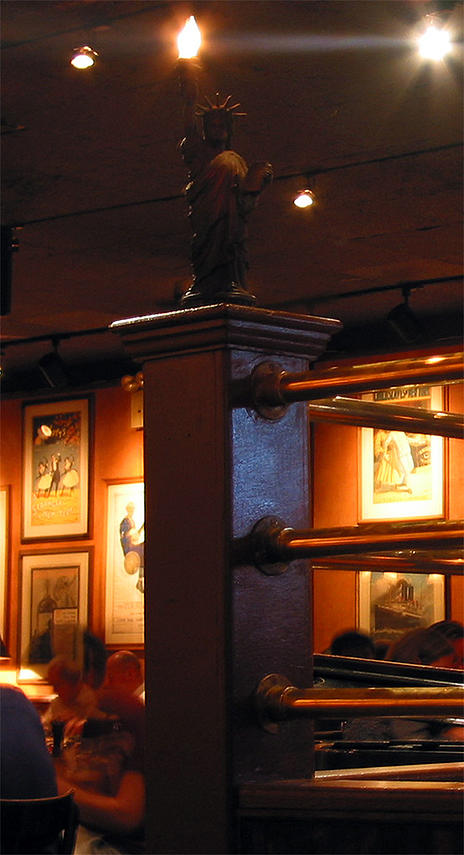 Knickerbocker Bar & Grill is one of those restaurants you walk by, year after year, and think, “I really ought to try that sometime.” You would have had plenty of chances to say that: the Knick has been on the same Greenwich Village street corner since 1977, remarkable longevity in a town where five years is a long run for a restaurant.
Knickerbocker Bar & Grill is one of those restaurants you walk by, year after year, and think, “I really ought to try that sometime.” You would have had plenty of chances to say that: the Knick has been on the same Greenwich Village street corner since 1977, remarkable longevity in a town where five years is a long run for a restaurant.




